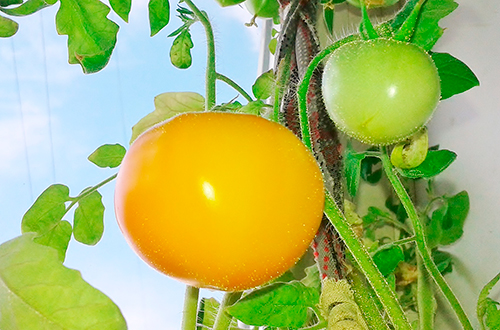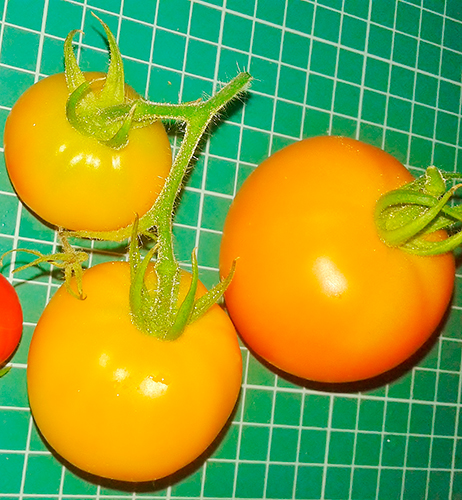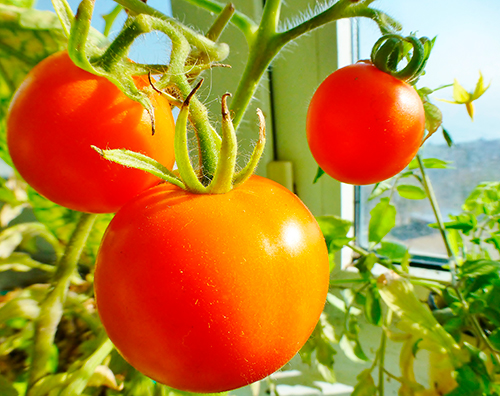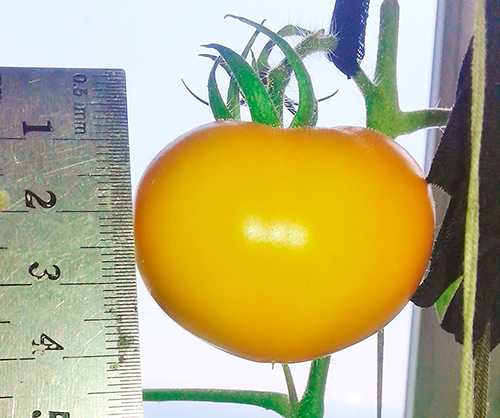Persimmon tomato variety
If you see Persimmon tomatoes from afar on the counter, then they can really be confused with a southern fruit growing on a tree. This similarity is of interest to gardeners, who will certainly want to learn about the characteristics of the culture. Brought out such an interesting variety in LLC "Seed-breeding company" Gisok ". The application for registration of the novelty entered the State Register of Plants of the Russian Federation in 1998, and in 1999 the variety was included in it. Suitable for growing in all regions of Russia. Recommended for open ground and unheated foil greenhouses. Not a hybrid.

Description
The plant is of a determinant type, 120 cm high, the growth of Persimmon is limited by the formation of a fruit cluster. Often, gardeners, describing a variety on the forums, indicate a growth that exceeds the declared one, especially in greenhouses. Bush with weak branching, while leafy enough. The leaves of the variety are large, petiolate, of a simple type, with a moderately pronounced venation, green. The stem is quite strong. The simple inflorescence consists of small yellow flowers. The first fruit cluster is laid over the 7th leaf, the subsequent ones appear every 1 or 2 leaves. The peduncle is articulated. The place of attachment of the stalk to the fruit is wide.

Tomatoes are visually attractive, have a flat-rounded or rounded shape, ribbing is poorly expressed. The skin is glossy, thin, but firm. Tomatoes are large, weighing 200 - 250 grams, according to the State Register - 240 grams. The unripe persimmon fruit is green in color and has a contrasting dark green spot at the stalk. When ripe, the stain disappears, and the color becomes bright yellow or golden-orange. The pulp of the variety is tender, juicy, fleshy, contains little liquid, the consistency is moderately dense, pleasant. The color of the pulp is uniform, orange. The number of seed nests is 4 or a little more, they are small, there are few seeds. The pulp is sweet on the palate, low in organic acids and high in carotene. The taste is excellent.

Characteristics
- Persimmon belongs to the mid-season varieties, the time from the appearance of full shoots to the beginning of ripening is 110 - 120 days;
- the cleaning period in warm areas lasts from July to September;
- the tomato yield is 5.8 kg per 1 square meter. Some forum users write about 3 kg from one bush;
- the immunity of the variety is average. According to reviews, in good weather the plant practically does not get sick, and chemical treatments can be dispensed with. But if the humidity is high, and there are few sunny days, then fungal pathogens may appear, late blight is especially dangerous;
- Persimmon belongs to the thermophilic. Outdoor cultivation is more suitable for southern regions. In cooler places, it is preferable to grow under a film shelter;

- in extreme heat, fruit setting may stop;
- the peel of overripe tomatoes may crack at the base;
- in cool regions, for example, in Bashkiria, at the end of the growing season, the remaining unripe tomatoes are removed, which are then perfectly ripened at room temperature;
- the crop endures long transportation. Ripe tomatoes are stored for up to a week, and green ones under suitable conditions are kept for more than a month;
- Persimmon has a salad purpose, but many housewives can successfully preserve elastic tomatoes and process them into juice.
Many seed companies are engaged in the distribution of seeds of the described variety. The description of the appearance and characteristics of such varieties does not always coincide with the description of the originator. Here are some examples.

- "Aelita". The plant is determinate, 70 - 100 cm high. The mass of a tomato is 300 grams. Color - golden orange. The period from germination to maturation is 110 - 115 days.
- "Plazmas". Determinant, height 70 - 100 cm. Mass of tomato - 250 - 300 grams. The color is deep golden orange. From full germination to the beginning of fruiting 115 - 125 days.
- "PTso". Determinant, height 70 - 100 cm.Fruit weight 100 - 250 cm. Coloring is golden-orange. From germination to the beginning of ripening, 115 - 125 days pass.
- "SeDeK". The plant is semi-determinate, 120 - 150 cm high. Fruits are large, weighing 300 - 400 grams. The color is golden orange. From full germination to the beginning of ripening, 107 - 112 days pass.
- Siberian Garden. The plant is medium-sized, 100 - 140 cm high. Fruits weighing 300 - 500 grams (up to 600 grams). The color is golden orange.
The reviews of those who first grew this variety differ in many respects. Someone's persimmon bush grew more than 2 meters in height, some complained about the short stature - 60 - 70 cm. The shape was also different - they wrote that the tomatoes were too flattened and very ribbed or heart-shaped. The color range of the pulp is sometimes bright yellow, there are complaints about the presence of red blotches in the orange pulp. The quality of the pulp and the taste did not suit many - for some they seemed too sour, some complained about the wateriness of the pulp and its tastelessness. According to experienced gardeners who have been growing the described variety for more than one year, it's all about the weather conditions and the intricacies of care. And excess acid appears when the tomato is overripe, and it can be difficult to distinguish a ripe fruit from an overripe one. And most importantly, do not buy seeds from unknown producers.
Agrotechnics
It is preferable to grow the variety in a seedling way. For seedlings, seeds are sown in the second decade of March. The pick is carried out in the phase of 2 true leaves. Seedlings, which are 2 months old, are planted in the ground, in terms of time this is the second decade of May. But one should take into account the peculiarities of the regions, in the southern ones, planting seeds and transplanting seedlings can be carried out a week earlier, in the northern ones - a week later. Planting scheme Persimmons - 40 cm between bushes, row spacing - 50 cm. Density - from 7 to 9 pieces per 1 square meter. Take a sunny place. The originators advise to form the plant into one stem with pinching and a garter to the support. In this case, the yield is good, the fruits are large and have time to ripen at the end of the growing season. But many people prefer to form a plant in 2 - 3 stems. In the south, you can leave up to 4 stems, since the beginning of autumn is always warm and the harvest will have time to ripen. Water the tomatoes carefully so that water does not get on the leaves. Excessive humidity is not needed, but the variety will not tolerate drought. The plant is demanding for the introduction of nutrients. During the period of formation of the ovary and ripening of the crop, it is necessary to use phosphorus-potassium fertilizers.
Persimmon is a great variety for lovers of sweet, meaty tomatoes. Caring for the plant is not difficult, but the harvest is always pleasing - the tomatoes grow bright, large and tasty. Good transportability and keeping quality are appreciated by farmers. In addition, the seeds can be successfully harvested by yourself.









I used this variety last and this year. Used both for preservation and for making juice, sauces and adjika. And this is despite the non-standard appearance of this tomato, because the bright orange fruit just asks for a plate or mouth. The skin of this tomato is thin and coarse, the flesh is fleshy, without a large number of white fibers, the taste is juicy, sweetish, with a barely noticeable sourness, which will increase as it matures. The variety is very early maturing, even when planted with seeds in the soil, began to bear fruit in the second half of June. It does not burst during conservation during processing with boiling water. It is advisable to grow on enriched light soils. Demanding during the ripening of fruits for watering. But it is impossible to flood the plants too much, since the fruits, with an excess of moisture, begin to burst and are exposed to the action of microorganisms, which lead to accelerated deterioration of the fruits.
The fruits of the Persimmon tomato are particularly sweet.For processing, they are rarely used, but this is not for everybody, they are mainly used fresh. It is worth noting that the bushes are formed undersized, which is very rare for yellow and orange tomatoes. In addition, the variety is characterized by relative resistance to late blight, however, this does not particularly save it ...
I recommend this tomato to all orange, juicy and sweet tomato lovers.
Last year they planted Persimmon. Very nice yellow-orange. We landed late, in early June, and began to sing along with everyone in early August. Produces sweet, juicy, medium-sized tomatoes. The skin is thin. Canned assorted - they look great, but much sweeter than red tomatoes.
Unfortunately, this year I failed to grow full-fledged seedlings and had to buy completely unfamiliar varieties on the market. Not finding my beloved Volovye Heart by taste, I decided to replace it with the Persimmon variety, little known to me.
Tomatoes in my region have produced a very poor harvest this year. Fruits, despite regular spraying, were affected by fruit rot by 70%. And only "Persimmon" pleased with its fruits, by the way, very similar in taste to "Volovye Heart". Fleshy, sweet and aromatic with few seeds, ideal for salads. Very large, they are not quite suitable for canning as a whole, as they do not fit in a jar.
This tomato was sold to me as a late one, but the fruits ripened along with the mid-season varieties. The bush is wide, about 80 cm high. It has a very high resistance to late blight and other diseases.
Among the disadvantages is the difficulty in tying up the bush, since it consists of several stems. And also the unusual yellow color of the fruit, sometimes misleading and seemingly unripe. Therefore, here you should focus on its softness.
In general, I liked the variety, and I was happy to add it to my collection.
I love tomatoes of a bright yellow (orange) color, so I have been growing Persimmon for many years. I must say right away that I did not have a "relationship" with this variety right away: it is susceptible to diseases, especially late blight, whitefly and spider mites willingly "eat" it, so in the first year of planting I was not happy with the variety - only a few fruits could ripen , but I really liked their taste. The next year, I was already prepared and could cope with all diseases and pests - the harvest pleased me: the shape of the tomatoes is pleasant - round and slightly flattened on the sides (well, the spilled persimmon), the color in full ripeness is bright and beautiful, the taste is sweet, the weight of the fruits is 300 - 350 grams. The size of the plants also pleased me - the bushes are compact, strong and low (I grow in the open field - they are not higher than a meter), I do without a garter. In general, I am satisfied with the variety and will continue to grow it, if it were not for the low resistance to diseases and the sour taste that appears in overripe fruits, then this would be my favorite variety.
I drew attention to this variety at the beginning of my gardening career, when, until the deepest autumn, I was harvesting from 10 persimmon bushes two to three times more than I removed from 40 bushes of Pink Giants. All my fruits are sweet, perhaps it depends on herbal infusions with yeast, with which I fertilize the seedlings. But, Persimmon has a special, very pleasant taste. Even my husband, who is indifferent to tomatoes, noticed that these orange ones are the sweetest. Small to medium sized, very thin skin and very tasty. Recently, I really enjoyed growing exotic varieties of tomatoes. What you can't buy on the market. But Persimmon is necessarily planted. For taste and productivity.
And I did a whole experiment on growing this variety from different seed producers, bought two different bags called Persimmon and planted in March. The seedlings turned out to be good and even the same, although the seeds are from different companies. I noticed surprises already in the greenhouse, the plants were different in height, but the most interesting thing began when the fruits began to set, their shape was not the same. So, after ripening, the fruits generally differed from each other, both in size and shape. From one manufacturer, these were up to 300 g of fruits that looked like persimmon fruit, from another - up to 150 g and oval, although they were the same in color. The taste was different too. Raised under the same conditions. As for me, these are different varieties.
I have been growing persimmon since 2015. I bought seedlings on the market in the spring, the fruits ripened, collected the seeds, which later took an honorable place in my collection. The variety does not like the heat (the fruits do not set well). Disease resistant. Not as sweet as White Sugar, but sweet too. Thin skin, unlike Peach and Orange peach. The color of the tomato is from light yellow to orange-brown.